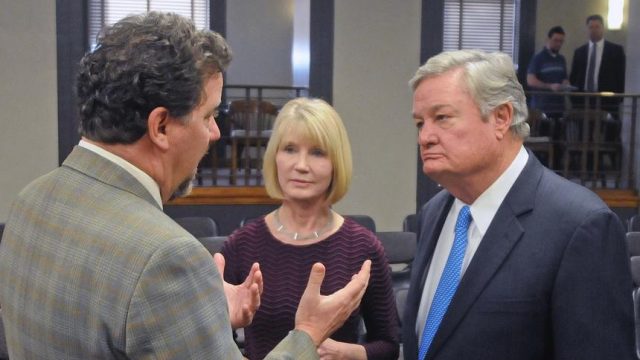North Dakota Lawmakers Have Got to Fix the Revenue Forecasting Problem

TOM STROMME/Tribune Eric Hardmeyer, left, president of the Bank of North Dakota speaks with Pam Sharp, director of the Office of Management and Budget, center, and Governor Jack Dalrymple after the governor announced a 4.05 percent cutback in spending for all state agencies to a meeting of directors of state agencies and elected officials on Monday in the Brynhild Haugland Room of the state capitol in Bismarck.
Here’s something a lot of people – even those who follow politics in North Dakota closely – don’t understand about our state’s budgeting process.
When lawmakers make a budget they aren’t spending money the state has. It’s not like the appropriations they make are drawn on a gigantic state checking account which runs a balance. Rather, the lawmakers make budgets to spend money they think they’ll have.
Every odd-numbered year the legislature meets in regular session starting in January. They conclude sometime in the spring – usually April or May – having produced a two-year budget for a biennium that will begin later that year on July 1 and end on June 30 of the next odd-numbered year.
[mks_pullquote align=”right” width=”300″ size=”24″ bg_color=”#ffffff” txt_color=”#000000″]…lawmakers were budgeting based on fundamentally bad information.[/mks_pullquote]
They know how much money they have to spend over that two-year window (or, at least, they think they know) because they get forecasts which predict tax collections.
But what if the forecasts are wrong?
It creates a very bad, no good situation.
Unfortunately, the state’s revenue forecasts have been wildly inaccurate for years now. During the height of the oil boom, in the 2011-2013 biennium, the revenue projections were low by about a billion dollars. According to the latest revenue report from the Office of Management and Budget, through May of this year current biennium revenues are more than a half billion below the forecast lawmakers used for their budget during the 2015 legislative session.
North Dakota lawmakers were always going to face a big challenge dealing with a budget inflated, and then subsequently deflated, by the vagaries of the commodities markets. Ag prices and oil prices are anything but stable, and when they swing the impact the state’s revenues in a big way. But on top of that, lawmakers were budgeting based on fundamentally bad information.
Not that this is an excuse for their spending. Heck, some of the lawmakers even liked the inaccurate forecasts back when the revenues were flowing in. I remember a Republican member of the state Senate telling me a few years ago that he was happy the forecasts were underestimating revenues at the time because, he felt, that helped keep the legislature from spending all the money.
It was a little frustrating to hear that fiscal restraint in a Republican legislature hinged on low-balling revenue forecasts. It’s all the more frustrating now that our problems with revenue prognostication are hitting the state budget from the other side, with forecasts overestimating revenues.
UND economist David Flynn has a post today looking at sales tax revenues specifically (they make up the biggest chunk of the state’s general fund revenues). He compares actual sales tax collections with predicted collections, and the picture the contrast paints is one of forecast incompetency:

I don’t care how competent policy makes are. I don’t care if they’re Republicans or Democrats or some other political flavor. You cannot build a sound budget based on bad information. And our state’s lawmakers have been getting bad information.
There are two possible fixes to the problem.
Either we go to a full-time legislature – or, at least, a legislature which meets more often – so that the budget can be tweaked when revenue forecasts are out of whack or we figure out a way to get more accurate forecasting.
Given the sort of mischief full-time lawmakers can get up to, I’d prefer the latter.
Moody’s Analytics is the company currently providing forecasting services to the state. It’s time to move on from them.




